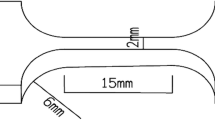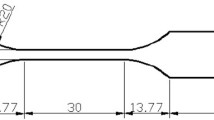This study characterized the temperature-dependent constitutive parameters (yield strength, ultimate tensile strength, elastic modulus, strain hardening exponent) from the mechanical behavior of five high-temperature solders, 95Sn-5Sb, 95Pb-5In, 90Pb-10Sn, 92.5Pb-5Sn-2.5Ag, and 93Pb-3Sn-2In-2Ag, chosen such that T m > 518 K. To model appropriately their mechanical responses under high-temperature thermal cycling, where the temperatures exceed 473 K, the material’s parameters must be determined as a function of temperature. Uni-axial tensile tests were, therefore, carried out between 298 K and 473 K to determine the constitutive behavior of each solder. 95Sn-5Sb exhibited the highest strength over the temperature range tested except near 473 K. Pb-based alloys with a higher degree of solid solution (>5%) showed greater strengthening than those primarily strengthened by coarse precipitates. Additionally, microstructure changes in 90Pb-10Sn and 95Sn-5Sb were shown to be responsible for unexpected mechanical behavior at elevated temperatures.
Similar content being viewed by others
REFERENCES
J.W. Morris and H.L. Reynolds, Proceedings of the Pacific Rim/ASME International Intersociety Electronic and Photonic Packaging Conference, INTERpack’97, vol. 2 (1997), p.␣1529.
J. Glazer, J. Electron. Mater. 23, 693 (1994).
T.T. Hitch, K. Palit, and A.N. Prabhu, International Conference on Electronic Assembly Material and Process Challenges, vol. 2 (1996), p. 1107.
N.C. Lee, Solder Surf. Mt. Technol. 9, 116 (1997).
M. Abtew and G. Selvaduray, Mater. Sci. Eng. Rep. R27, 95 (2000).
J.H. Vincent and G. Humpston, GEC J. Res. 11, 76 (1994).
E. Suhir, Adv. Therm. Model. Electron. Compon. Syst. 1, 337 (1988).
B. Royce, Intersociety Conference on Thermal Phenomena Fabrication and Operation of Electronic Components, vol.␣11 (1998), p. 171.
H. Nose, M. Sakane, Y. Tsukada, and H. Nishimura, J. Electron. Packag. 125, 59 (2003).
S. Wen, L. Keer, S. Vaynman, and L. Lawson, IEEE Trans. Compon. Packag. Technol. 25, 23 (2002).
W. Jones, Y. Liu, M. Shah, and R. Clarke, Solder Surf. Mt. Technol. 10, 37 (1998).
A. Miric and A. Grusd, Solder Surf. Mt. Technol. 10, 19 (1998).
H.J. Fecht, M.X. Zhang, Y.A. Chang, and J.H. Perepezko, Metall. Trans. A 20A, 795 (1989).
D. L. Decker, J. Weiss, and H. B. Vanfleet, Phys. Rev. B 16, 2392 (1977).
A. Ascoli, L. Filoni, G. Poletti, and S. L. Rossi, Phys. Rev. B 10, 5003 (1974).
T. Massalski, Binary Alloy Phase Diagrams (Metals Park, OH: ASM International, 1986).
J. Shigley, Mechanical Engineering Design (New York: McGraw-Hill, 2004).
G. Dieter, Mechanical Metallurgy (Boston: McGraw-Hill, 1986).
ACKNOWLEDGEMENTS
The authors would like to thank Joe Krisciunas, Tony Colucci, Colin Mackenzie, and Roger Jones for their support of this program. This material was based on the work supported by the Department of Energy under award DE-FC26-06NT42950. This paper was prepared as an account of work sponsored by an agency of the U.S. Government. Neither the U.S. Government or any agency thereof, nor any of their employees, makes warranty, express or implied, or assumes any legal liability or responsibility for the accuracy, completeness, or usefulness of any information, apparatus, product or process disclosed, or represents that its use would not infringe on privately owned rights. Reference herein to any specific commercial product, process, or service by trade name, trademark, manufacturer, or otherwise does not necessarily constitute or imply its␣endorsement, recommendation, or favoring by the␣U.S. Government or any agency thereof. The views and opinions of the authors expressed herein do not␣necessarily state or reflect those of the U.S. Government or any agency thereof. The Government reserves for itself and others acting on its behalf a royalty-free, nonexclusive, irrevocable, worldwide license for governmental purposes to publish, distribute, translate, duplicate, exhibit, and perform this copyrighted paper.
Author information
Authors and Affiliations
Corresponding author
Rights and permissions
About this article
Cite this article
Schoeller, H., Bansal, S., Knobloch, A. et al. Microstructure Evolution and the Constitutive Relations of High-Temperature Solders. J. Electron. Mater. 38, 802–809 (2009). https://doi.org/10.1007/s11664-009-0767-6
Received:
Accepted:
Published:
Issue Date:
DOI: https://doi.org/10.1007/s11664-009-0767-6




